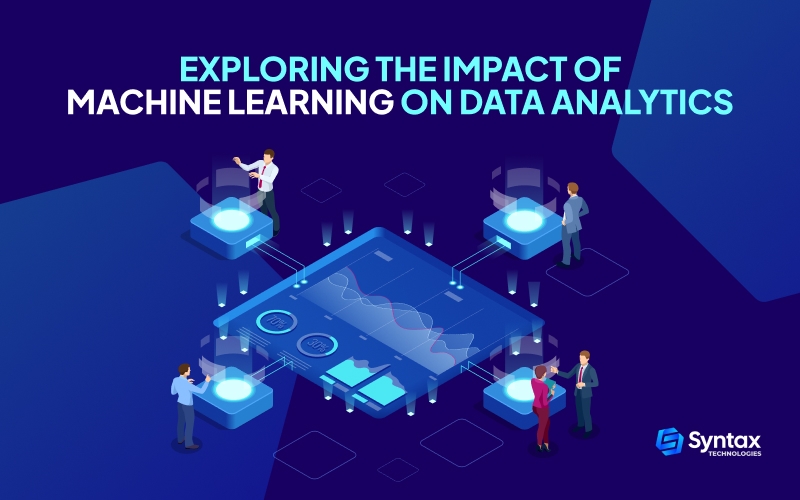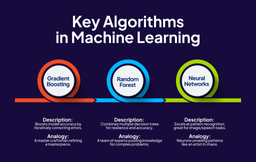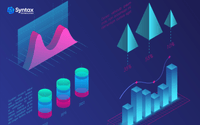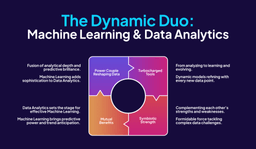Hey there, data enthusiasts!
Welcome to the riveting world where data analytics meets the cutting edge.
Buckle up as we embark on a journey to explore the seismic impact of machine learning systems on the ever-evolving landscape of data analytics.
Machine learning is a fusion of brainpower and binary brilliance, where algorithms don superhero capes and transform raw data into strategic data mining.
It’s not just a tech revolution; it’s a friendly invasion of zeros and ones reshaping the way we decipher the language of information.
If you want to be at the forefront of this race, it will be highly beneficial to sign up for a data analytics course to get your gear ready for the big leagues!
Now get ready to surf the waves of innovation as we unravel the mysteries behind Machine Learning and Data Analytics!
The Basics: Understanding Machine Learning
Definition and Concepts
Let’s kick things off with the ABCs of our technological wonderland: Machine Learning.
Imagine it as the wise, digital sage that learns and evolves with each new piece of information it encounters.
In simple terms, it’s the art of teaching computers how to think for themselves. We’re talking about algorithms donning their learning caps, not just following instructions but actually adapting and getting smarter over time.
It’s like the classroom of the future, where the student (our algorithm) not only listens but grows wiser with each lesson.
Key Algorithms in Machine Learning
Now, let’s dive into the superstar algorithms that make the magic happen. Think of them as the superheroes of our data universe.
There’s the swift and powerful Gradient Boosting, the intuitive Random Forest, and the ever-curious Neural Networks.
1. Gradient Boosting:
- Description: A technique that enhances the predictive accuracy of models by iteratively correcting errors, creating a robust and fine-tuned predictor.
- Analogy: Think of it as a master craftsman meticulously refining a piece of art, adjusting details until perfection is achieved.
2. Random Forest:
- Description: An ensemble learning method that combines multiple decision trees to create a more resilient and accurate model.
- Analogy: Picture a collaborative team of experts pooling their knowledge to solve a complex problem, each contributing a unique perspective.
3. Neural Networks:
- Description: Modeled after the human brain, Neural Networks excel at recognizing patterns and are particularly potent in tasks like image and speech recognition.
- Analogy: Envision an interconnected web of neurons working in harmony to unveil intricate patterns, much like an artist revealing the beauty within chaos.
Each has its own superpower, from recognizing patterns to making predictions with jaw-dropping accuracy.
It’s like assembling a dream team, each member bringing a unique skill set to conquer the challenges of the data realm.
How Machine Learning Has Changed How We Analyze Data
Now, let’s address the elephant in the server room: how is Machine Learning different from our good old traditional data analytics?
Well, while traditional analytics is like following a recipe to cook a familiar dish, Machine Learning is the culinary genius that invents new recipes by learning from every flavor, spice, and cooking technique it encounters.
It’s not just analyzing the past; it’s predicting and adapting to future culinary trends before they even hit the menu.
We’re just scratching the surface of this captivating world where machines become the ultimate learners and data becomes a canvas for innovation!
The Evolution of Data Analytics
Historical Perspective
Let’s embark on a captivating journey through the annals of data analytics, tracing its evolution from humble beginnings to the powerhouse it is today.
Picture the early days when data analysis was more like peering through a foggy window. Analysts relied on basic statistical methods, making sense of data with a mixture of intuition and limited tools.
As time marched forward, the digital revolution ushered in a new era. Computers became our allies, allowing us to process larger datasets with greater speed.
The emergence of relational databases and SQL brought structure to the chaos, turning data into a more manageable resource.
Traditional Approaches vs. Modern Trends
Fast forward to the present, and traditional data analytics has undergone a metamorphosis. What was once a reactive process, looking backward to understand historical trends has evolved into a proactive, forward-thinking discipline.
Advanced statistical methods, coupled with interactive visualization tools, now allow analysts to explore data dynamically, uncovering insights in real time.
Modern trends have shifted the focus from hindsight to foresight. Predictive analytics and machine learning algorithms have become integral, enabling organizations to anticipate future trends and make informed decisions.
It’s no longer just about understanding what happened; it’s about predicting what will happen and preparing for it.
Challenges Faced by Conventional Data Analytics
However, with progress comes challenges. Traditional data analytics, while foundational, grapples with the sheer volume and complexity of contemporary datasets. The demand for real-time insights requires a reevaluation of tools and methodologies.
Privacy concerns and ethical considerations also loom large, prompting a need for responsible and transparent data practices.
In this age of data enlightenment, our exploration into the evolution of data analytics is not just a stroll down memory lane; it’s a dynamic narrative of adaptation, innovation, and the continuous quest to unravel the full potential of data.
As we navigate the twists and turns of this narrative, we’ll witness how data analytics has transformed from a nascent discipline into a driving force behind informed decision-making.
The Dynamic Duo: Machine Learning and Data Analytics
Integration and Collaboration
In the vast expanse of data exploration, enter the power couple that has reshaped the game: Machine Learning and Data Analytics, the dynamic duo of the digital era.
Their partnership is not a mere collaboration; it’s a symphony of insights, a fusion of analytical prowess and predictive intelligence.
Machine Learning seamlessly integrates into the fabric of Data Analytics, adding a layer of sophistication to the traditional methods.
It’s like giving our analytical tools a turbocharged engine ? suddenly, they’re not just analyzing; they’re learning, adapting, and evolving.
This integration means that our analytical models aren’t static; they’re dynamic entities, refining themselves with each new piece of data they encounter.
Mutual Benefits and Synergies
The marriage of Machine Learning and Data Analytics isn’t a one-sided affair. Both partners benefit from this union.
Data Analytics provides the context and foundation for Machine Learning algorithms to operate effectively. It sets the stage, defines the problems, and identifies the patterns that need unraveling.
On the flip side, Machine Learning brings predictive capabilities to the table. It’s the clairvoyant companion that anticipates trends, identifies outliers, and unveils hidden patterns within the vast datasets.
Together, they create a symbiotic relationship where the strengths of one complement the weaknesses of the other, resulting in a formidable force capable of tackling complex data challenges.
Impact on Decision-Making
Enhanced Predictive Analytics
Machine Learning, with its ability to discern patterns and foresee trends, has revolutionized predictive analytics. No longer are decisions bound by historical data alone; they’re shaped by algorithms that can anticipate future scenarios with uncanny accuracy.
Consider a scenario in finance: traditional analytics might assess past market trends, but Machine Learning takes it a step further.
It can analyze current market sentiment, global events, and a myriad of variables to forecast potential shifts.
This enhanced predictive capability doesn’t just inform financial decisions; it empowers organizations to stay ahead of the curve, adapting to changes before they occur.
Improved Insights and Recommendations
Data Analytics has always been about extracting insights, but the integration of Machine Learning elevates this process.
Imagine an e-commerce platform that not only tracks user behavior but also learns from it.
Machine Learning algorithms can decipher complex patterns in purchasing behavior, preferences, and even subtle nuances, enabling the platform to provide personalized recommendations that resonate with individual users.
In healthcare, this dynamic duo transforms patient care. Machine Learning algorithms analyze medical records, predict potential health risks, and recommend personalized treatment plans.
It’s not just about big data anymore; it’s nearly precise, targeted insights that guide decisions tailored to specific needs.
Case Studies Illustrating Informed Decision-Making
Let’s delve into real-world success stories. Picture a manufacturing company optimizing its supply chain with Machine Learning techniques and algorithms predicting demand fluctuations.
As a result, inventory management becomes proactive, reducing costs and preventing stockouts.
In marketing, a social media platform utilizes predictive analytics to tailor user content recommendations.
Engagement soars as users are presented with content they didn’t even know they wanted, thanks to the astute predictions of Machine Learning algorithms.
These case studies aren’t just anecdotes; they represent a paradigm shift in decision-making.
The transformative impact of data analytics is turning reactive data responses into proactive, informed strategies based on past insights and future predictions.
Overcoming Challenges in Machine Learning
Ethical Considerations
As we sail through the sea of data analytics and machine learning, we must navigate the ethical waters that come with it. The power to predict and prescribe brings with it a responsibility to do so ethically.
Issues of bias in algorithms, privacy concerns, and the potential misuse of predictive capabilities demand our careful attention.
Consider a hiring algorithm trained on historical data that inadvertently perpetuates biases present in the data, leading to discriminatory outcomes.
Ethical considerations in this realm involve not only recognizing and rectifying biases but also ensuring that the decision-making processes are transparent and accountable.
The challenge is not just technological; it’s a moral compass guiding us through the complex landscape of data-driven decision-making.
Data Security and Privacy Concerns
In our quest for data-driven insights, the fortress of security and privacy must remain impregnable. As the volume and sensitivity of data increase, so do the risks.
Machine Learning models, while powerful, are only as trustworthy as the data they are trained on. Protecting this data from unauthorized access and ensuring its integrity becomes paramount.
Consider a healthcare system utilizing Machine Learning to predict patient outcomes. The data involved is not just numbers; it’s deeply personal and sensitive information.
Safeguarding this information against cyber threats and unauthorized access is a continuous battle.
Overcoming this challenge involves not only robust cybersecurity measures but also a cultural shift towards prioritizing data privacy.
Addressing Bias in Machine Learning Models
Algorithms, like their human creators, can unwittingly perpetuate biases present in the data they are trained on.
This presents a twofold challenge: first, recognizing and understanding the biases, and second, mitigating their impact on decision-making.
This challenge requires a multi-faceted approach involving diverse and inclusive data collection, continuous monitoring of model outputs for bias, and developing fair and transparent algorithms.
Imagine a loan approval system inadvertently favoring one demographic over another due to biased training data.
Addressing this challenge requires not only refining the algorithms but also fostering a culture of awareness and accountability.
Future Trends in Machine Learning
Advancements on the Horizon
As we gaze into the crystal ball of technology, the future of Machine Learning and Data Analytics unfolds with promises of unprecedented advancements.
Quantum leaps in computational power, fueled by emerging technologies like quantum computing, are poised to revolutionize the scale and speed at which data is processed.
The horizon beckons towards algorithms that can tackle even more complex problems, opening doors to new frontiers in artificial intelligence.
Consider a future where Machine Learning models not only predict outcomes based on historical data but actively engage in continuous learning and adaptation.
Imagine algorithms capable of grasping intricate causal relationships, unlocking the ability to predict and influence outcomes in ways previously deemed magical.
The evolution of neural networks may lead to more brain-like structures, pushing the boundaries of what machines can comprehend and create.
Potential Disruptions in the Field
The future isn’t just a linear progression; it’s a dynamic landscape ripe for disruptions. The rise of Explainable AI (XAI) is one such disruptor.
As Machine Learning models become more intricate, understanding their decision-making processes becomes crucial.
Explainable AI seeks to demystify the black box, providing insights into how algorithms arrive at specific conclusions. This will enhance transparency and address concerns related to bias and ethical considerations.
Consider a scenario where a healthcare provider utilizes an AI system to recommend treatment plans. The ability to explain why a particular recommendation is made is not just a feature but a necessity for trust and accountability.
Explainable AI is set to reshape the narrative, making Machine Learning more accessible and accountable.
Anticipated Developments in Machine Learning for Data Analytics
The future of Machine Learning in Data Analytics is deeply intertwined with the democratization of AI. As tools and platforms become more user-friendly, the barrier to entry for businesses and individuals diminishes.
This democratization extends beyond technical experts, empowering domain specialists to harness the power of Machine Learning in their respective fields.
Imagine a future where a marketing professional can employ advanced analytics without being a data scientist or a healthcare practitioner using predictive models without extensive coding skills.
This shift democratizes the benefits of Machine Learning, making it an integral part of decision-making across diverse sectors.
Empowering Tomorrow: Navigating the Data Frontier with Syntax Technologies
Our journey through the impact of Machine Learning on Data Analytics has been nothing short of exhilarating.
We’ve witnessed the fusion of analytical wisdom and predictive intelligence, seen how algorithms reshape decision-making, and navigated the ethical waters that come with this transformative power.
But the journey doesn’t end here; it transforms into a new chapter of empowerment.
In this era of data enlightenment, Syntax Technologies emerges as a beacon guiding enthusiasts, professionals, and businesses toward a deeper understanding of data analytics.
Our course, meticulously crafted, is not just an education; it’s a key to unlocking the doors of insights.
Whether you’re stepping into the world of Machine Learning and Data Analytics for the first time or switching careers, Syntax Technologies provides a roadmap.
Our course is designed not just to impart knowledge but to foster a mindset ? a mindset that sees data not as a challenge but as an opportunity and analytics not as a tool but as a strategic ally.




